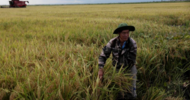PRNewswire | 4 March 2011 | français
NEW YORK and LONDON, March 4, 2011 /PRNewswire/ — Farm Lands of Guinea Limited (“FLG”) which through its 90%-owned subsidiary, Land & Resources (Guinea) SA (“Land & Resources”) controls nearly a quarter of a million acres of underutilized West African agricultural holdings under an agreement with the Ministry of Agriculture of Guinea (“MAG”), announced today that it has completed a reverse merger and investment with Kryptic Entertainment Inc. (the “Company”) valuing the Company at USD$45 million, and is now a publicly-traded company in the U.S. (OTC Bulletin Board: KTCE). In the financing the Company sold common stock in a private placement to certain investors for an aggregate gross purchase price of USD$1,000,000.
Land & Resources is a development stage agricultural company in the Republic of Guinea (“Guinea”). It intends to engage in acquiring and consolidating farm land and operations in Guinea and rehabilitating them back into production using modern agricultural techniques and practices. Land & Resources currently plans to develop 8,815 hectares in the villages of N’Dema and Konindou to grow maize and soybeans in rotation as a pilot scheme for the development of 98,400 hectares lying to the south and east of Saraya.
Pursuant to the Contract for a Program of Agricultural Development in Guinea dated September 16, 2010 (the “Contract for Development”), MAG has agreed to grant to Land & Resources 99-year leases over two parcels of land in the villages of N’Dema and Konindou of 5,340 and 3,475 hectares respectively to be developed as agricultural land.
On the same date, Land & Resources and MAG entered into an Option Agreement (the “Option Agreement”) pursuant to which Land & Resources was granted an option to assume a lease of approximately 98,400 hectares (243,151 acres) located in the village of Saraya in Guinea (the “Option Land”).
On October 25, 2010 Land & Resources signed a Protocol d’Accord with MAG (the “Protocol D’Accord”) under which the Company undertook obligations to survey and map additional underutilized land in Guinea estimated to be up to 1.5 million hectares (3.7 million acres) of combined area and prepare it for third party development under 99-year leases.
FLG proposes to develop the leased land to grow in rotation, maize and soybeans. Given the rainfall, the temperature profile and the nature of the soil, it is anticipated that the land when developed will produce about 4 tons of soybeans per hectare. The rotation will be one year of maize followed by two years of Soya. FLG’s program represents a major breakthrough for the new democratically-elected government of the Republic of Guinea in their priority plans for food self-sufficiency. The completion of FLG’s agricultural activities will result in a multi-million dollar inward investment into the Republic of Guinea.
REPUBLIC OF GUINEA BACKGROUNDER
The Republic of Guinea is a former French Colony. It is a West African country on the North Atlantic Ocean, bordering Senegal, Mali, Ivory Coast, Liberia, Sierra Leone and Bissau. It is part of the emerging African reformation chain and now presents the optimum timing opportunity for investment in agriculture. Conakry with a population of approximately 1.5 million people is the largest city and the seat of the National Government. The Country has a population of approximately eight million. The official language is French and the principal religion is Islam.
The government was essentially a military dictatorship until the end of 2010, when following free and democratic elections, His Excellency Professor Alfa Conde was elected as President. Guinea has abundant natural resources, including significant gold and diamond deposits and also more than one third of the world’s known bauxite reserves. Even during problematic periods the country has always had a strong mining sector. By contrast, although agriculture accounts for 24% of its GDP and employs 84% of the active population, the sector has stagnated since independence and less than 3% of Guinea’s arable land is currently being cultivated.
The Guinean Government adopted policies in the 1990s to return commercial activity to the private sector, promote investment, reduce the role of the state in the economy and improve the administrative and judicial framework. The Government revised the private investment code in 1998 to stimulate economic activity in the spirit of free enterprise. The code does not discriminate between foreigners and nationals and allows for repatriation of profits. It is undeniable that there are numerous problems facing the Guinea economy, but this has not detracted a wide range of foreign investors, notably large international aluminum producers, Australian, British, Canadian and Swiss mining consortia prospecting for gold, diamonds and other metals and more recently the China International Fund announced its intention to invest $7 billion in infrastructure projects.
Multinational corporations currently operating in Guinea include BHP Billiton, Rio Tinto, RUSAL, Royal Dutch Shell, and Dana Petroleum, among others. Guinea is a fertile country. Its mineral resources have pushed the development of agriculture into second place. Its present subsistence model cannot adequately feed its increasingly urban population. Its plentiful rain fall and virgin soil offer opportunities to create an export business in a world with a growing demand for food.
Since independence in 1958 much of the arable land in the Republic of Guinea has been neglected. The once vibrant agricultural sector has largely disappeared. The Ministry of Agriculture has therefore been examining ways to regenerate vast areas of scrubland and make it suitable for modern methods of agriculture. Recognizing that Guinea’s climate is suitable for the production of a number of crops including Soya, the Ministry of Agriculture has been seeking partners to assist it in developing this aspect of Guinea’s resources.
Corn-like Maize is a staple food in Guinea. According to data collected by the Ministry of Agriculture of Guinea, there is currently a national shortfall of 500,000 tons of this product which to date has been filled with importation from international markets. Local production is carried out by farmers and does not involve use of fertilizer, mechanized tools and machinery. As a result, the yields of the crop are poor and well below the needs of the local market.
Bean crop Soya is not in significant production in Guinea. There is currently a substantial consumption shortfall in home produced cooking oil for which manufactured Soya or soybeans is particularly well suited. The shortfall is compensated for by importing Soya derived oil from international markets. The three major regions where Soya is grown profitably are the United States of America, Brazil, and Argentina. Each of them suffers local disadvantages. Farmers in the United States face first world costs. The Brazilians have to cope with vast distances and poor roads. In Argentina the government retains 35% of the gross yield at no charge. By contrast, the government of the Republic of Guinea actively promotes rather than penalizes production.
CONTACTS:
Michael Barton, CFO
Farm Lands of Guinea
+44 1257 480597
http://www.farmlandsofguinea.com
Dan McClory, Managing Director
Hunter Wise Financial Group, LLC
Irvine, California
+1 949 732 4102
[email protected]













